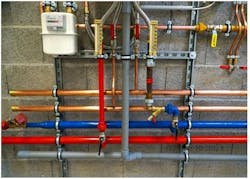What you'll learn:
- What are the main trends driving IoT adoption?
- The challenges that stand in the way of IoT adoption.
- A DIY approach to IoT implementation, and the potential pitfalls when going that route.
- Finding the right technology stack for IoT implementation.
Internet of Things (IoT) implementations continue to grow at amazing pace in various industry segments as the IoT becomes a key factor to differentiate and provide additional value to otherwise standalone devices.
This article covers current trends in IoT technology adoption and the implementation challenges faced by embedded developers. It’s followed by a recommendation for successful execution to ensure IoT-connected devices are developed to meet time-to-market expectations as well as meet long-term evolution.
IoT Adoption Trends
Key trends driving IoT adoption are:
- The ubiquitous presence of smartphones with applications encompassing every aspect of our lives is driving a similar connected digital experience expectation around other devices. For example, traditional standalone devices like thermostats or air compressors are now increasingly developed as connected devices with a digital user experience around them.
- IoT connectivity allows device builders to continue to manage devices after they’re sold and deployed in the field. Device builders can provide remote firmware updates to keep devices secure, or they can offer to remotely maintain and service the devices.
- As the compute and storage resources grow on IoT-enabled devices, they’re becoming more capable of providing a local real-time response with growing level of intelligence and autonomy. This intelligence typically relies on data analysis and machine learning done in the cloud and then continually feeding improvements to local intelligence on the device.
- IoT capabilities enable device builders to provide additional value-added services around their devices. This also can lead to business transformation where the device builder focuses on selling the outcome instead of the device (e.g., selling compressed gas as a service instead of selling compressors).
IoT Adoption Curve
Initial IoT adoption focus may be different from organization to organization. However, over time, as the learning and experience in IoT continues to grow, new use-cases are identified and implemented. Overall, the IoT enablement can be considered as a journey where humble beginnings multiply over time and eventually lead to business transformation.
A typical IoT adoption journey at an organization may start with some simple proof of concept that’s followed up by offering connected device experiences to the user, such as remote on/off or collecting, visualizing, and analyzing telemetry data (Fig. 1). This can be followed by adding capabilities to remotely manage and service the device.
In addition, as more insights are discovered from the collected data, the device builder can provide additional value-added services, including energy management, predictive maintenance, etc. Eventually, the device builders are able to bring in new business models around their devices, where they focus on selling outcomes instead of selling the device.
One key observation to make here is the that this journey continues to evolve over time and builds on top of initial capabilities. The overall complexity of the solution and the underlying implementation grows as the solution increases in value as does its feature set.
IoT Adoption Challenges
By definition, IoT implementation consists of multiple interoperating domains. It involves “things” that are typically embedded devices of varying capabilities. They consist of data collection and processing capabilities (IoT platform) and connect to the “internet,” as well as provide a user interface for end users, either web or mobile applications.
With this layering definition in mind, some of the key challenges inherent to an IoT implementation include:
- Security: Keeping each layer secure throughout the lifecycle of the IoT implementation is a key challenge. All interoperating domains have different needs to keep them secure. For example, the embedded devices require firmware updates with security vulnerability fixes that may have been identified after deployment. The IoT platform and applications also need package updates and require maintaining access controls at different levels. Cyberattacks causing disruption to operations and critical infrastructure are among the top five rising global risks.1
- Keeping up with technology: In general, lots of activity goes on at each implementation layer, where new technology is introduced quite frequently and old components become obsolete. As IoT-enabled devices can be deployed and remain active in the field for long period of time, it’s important to provide feature and technical updates to each layer to stay relevant.
- Compliance: New regulatory compliance at government, industry, or at an organizational level continues to emerge that requires tweaks or adjustments to the IoT implementations.
- Cost management: Keeping the cost of IoT implementation in check is another challenge faced by device builders because it can grow substantially over time, as integration between different layers is realized and they’re operated as an IoT solution for longer periods of time.
- Scalability: IoT implementations need to scale over time, both horizontally where more devices will be extensively connected, and vertically where more services and systems will need integration as the IoT solution journey moves up the adoption curve.
IoT Implementation Approach
Starting an IoT journey can be deceptively simple. All one needs to do is take community hardware, install pre-configured open-source software/applications, add an internet connection to one of the free IoT platform accounts, and start visualizing data via one of the freely available dashboarding applications. This simplicity is quite useful on one hand, as it helps quickly try out simple IoT use-cases, but on the other hand can be quite risky as it pushes organizations to homegrown IoT implementations.
As described above, this is just a starting point on a long journey. Using a DIY approach opens the door to several potential challenges, such as security and threat management, technology updates, compliance, development and integration cost, and future scalability needs.
This approach is particularly problematic in the long run, even if there are early wins, as the cost to operate and maintain the overall solution keeps growing. Oftentimes, organizations spend resources on integrating and hardening technology areas that aren’t their core strength and moves their focus away from the domain-specific applications that provide real value to their customers.
For example, a boiler manufacturer or solar system manufacturer needs to focus on building differentiated applications for their customers instead of consuming resources to build and operate the five layers needed as a base for an IoT solution, as discussed above.
Most businesses underestimate the risks and challenges of the DIY model as “less than 30 percent have taken their IoT programs beyond the pilot phase.” 2 They require increasingly more resources to maintain and keep secure. In 2020, reported security vulnerabilities reached 18,325 (average > 350 per week),3 so just to navigate and keep up with the newly identified threats each week is a significant effort.
The Plumbing Analogy
A good analogy in this case is to consider the best approach to get plumbing done at one’s house. The plumbing system should be reliable, work efficiently, and comply to all applicable building codes and regulations (Fig. 2).
The obvious choice to get plumbing done is to call the experts and get it finished quickly so that one can quickly start using it. It will be far more costly and time-consuming to learn how plumbing works, and then put together an actual working plumbing system. The added advantage of the first approach is that expert support is a call away should there be any leaks or other issues in future.
In the same way when starting an IoT journey, the best decision is to get a working system that comes integrated with five layers of technology required for IoT (Fig. 3). The in-house team can focus on building domain-specific, value-added services to acquire a competitive edge in the market.
Here, the real discussion should be about efficiency and economics, not about the ability to develop a solution in-house. It just makes sense to get an integrated, cost-effective, reliable, and supported base to start the IoT journey instead of spending valuable in-house resources.
The 80-20 Solution
The best approach to embark on an IoT journey is to find a technology stack that provides a strong foundation for various layers of IoT implementations. This can be considered as an 80-20 solution mix, where 80% of the solution doesn’t differentiate between a boiler or a compressor, and 20% of the IoT solution is based on domain know-how specific to the boiler or compressor. The ideal solution is end-to-end integrated, hardened, and offers flexibility to support domain-specific customization (Fig. 4). Furthermore, it continually evolves as the technology moves forward.
An example of one such solution is offered by Siemens Digital Industries Software, providing an end-to-end technology stack encompassing different layers required for an IoT implementation (Fig. 5). The technology stack consists of Siemens’ MindSphere, a feature-rich, cloud-agnostic IoT platform and embedded software from Siemens Embedded.
The solution comes with implementation of applications (fleet management, remote device management, visualization, and dashboarding etc.) This allows device builders to quickly bring IoT implementations to market that are ready to support their growth and business transformation goals.
Summary
IoT adoption is on the rise and today’s device builders are scrambling to create feature-rich connected devices with digital experiences around them. Short- and long-term challenges need careful consideration when adopting foundational technology for an IoT implementation, as it will need to be maintained, evolved, and supported for the lifecycle of the product.
A DIY approach to stitch together a modern, secure, scalable, and compliant solution in a cost-effective manner may not be sufficient, as there are too many risk factors to consider. It may be more efficient to seek a proven, off-the-shelf technology stack to build an IoT offering. This approach can helps mitigate the risks and enables device builders to focus on customized applications and rich features that can differentiate their products from competitors.
To explore Siemens IoT solutions, visit:
https://siemens.com/mindsphere
References
1. 2020 Global Risk Report, World Economic Forum
2. What separates leaders from laggards in the Internet of Things, McKinsey
3. Vulnerabilities By Year, CVE Details
About the Author
Muhammad Shafique
Solution Architect, Embedded Platforms, Siemens Digital Industries Software
Muhammad Shafique is a solution architect for Embedded Platforms, Siemens Digital Industries Software with over 19 years of experience in the embedded software industry. His experience spans from deeply embedded software (booting strategies, operating systems, and multicore solutions) all the way up to the higher layers of embedded software stack and embedded device management in cloud (Internet of Things stacks/protocols, industrial connectivity protocols). Muhammad holds a bachelor’s degree in Electrical Engineering from the University of Engineering & Technology in Lahore, Pakistan.





